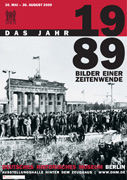


Exhibition | Heavy Times | Peaceful Revolution | International Politics | West Looks East
Since the beginning of the 1980s the GDR was increasingly marked by stagnation in all areas of society. The supply situation and the economy were becoming more and more precarious from one year to the next. Internal calculations by the Party from the years 1988 and 1989 revealed that from 1990 on East Germany would be unable to pay the interest on its foreign debt due to a lack of revenue in foreign currencies.
Nevertheless, the unity of economic and social policy propagated by head of state Erich Honecker since the middle of the seventies remained untouched. It was characterized by a policy of strong subsidies in the areas of housing, work output and food staples. Construction and restoration of residential flats within the cities declined in favour of new buildings on the outskirts, workers’ wages were higher than the value of the goods they produced, and basic foodstuffs were cheaper than fodder. The national economy lived off the country’s substance. Investments in trade and industry, ecology and infrastructure were no longer adequately undertaken.
When the Soviet Union began introducing domestic and foreign-policy reforms in the mid-eighties, the SED leaders stuck to their own government model, which they now extolled as Socialism in the colours of the GDR. In view of the reluctance of the SED leadership to reform, the people felt resigned and many wanted to leave the country. Only a few reckoned with new initiatives. Opposition activists joined human rights and environmental groups. Large sectors of the younger generation refused to support the social system of the SED.
